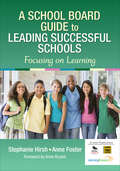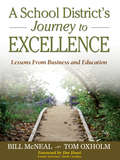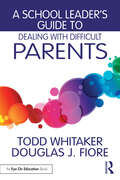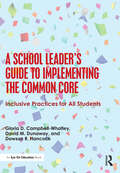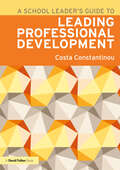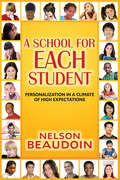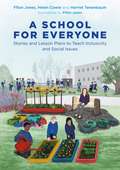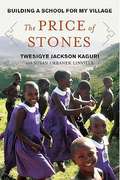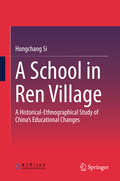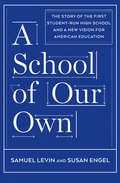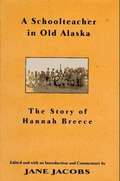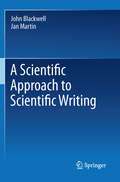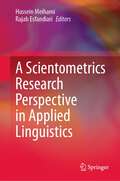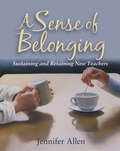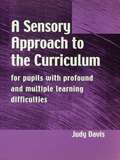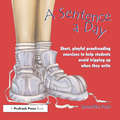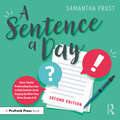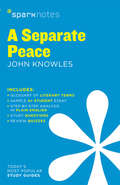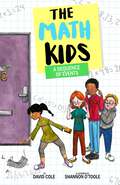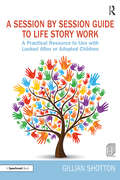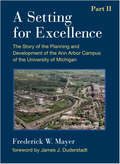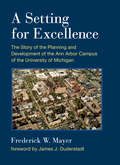- Table View
- List View
A School Board Guide to Leading Successful Schools: Focusing on Learning
by Dr Stephanie A. Hirsh Anne W. FosterThe go-to resource for school board members’ greatest challenges! This invaluable guide addresses the top challenges experienced by nearly every school board, and shows how professional learning can support positive change throughout a school system. Effective for individual study or group learning, this resource helps board members to: Learn from case studies focused on 12 critical board-level decisions, including hiring a new superintendent, resource allocation, compensation planning, and more Know when, where, and how to use professional learning to improve individual and districtwide performance Benefit from best practices and tools developed to support effective decisions and successful implementation of major initiatives
A School District’s Journey to Excellence: Lessons From Business and Education
by William R. Mcneal Thomas B. OxholmThis resource examines how one of the nation's largest districts improved performance outcomes and achieved significant gains by integrating strategies from educational and business arenas.
A School Leader's Guide to Dealing with Difficult Parents
by Todd Whitaker Douglas J. FioreThis new supplement to the bestselling Dealing with Difficult Parents, 2nd Edition is designed to help you with the specific challenges you face as a school leader when dealing with parents. The main book, Dealing with Difficult Parents, 2nd Edition, shows how your teachers and other educators can communicate with parents more effectively. With this new supplement, you’ll learn how you, as a leader, can--and must--support and coach teachers along the way. Topics covered include how to… Make sure your teachers understand the families they’re dealing with; Help your teachers communicate effectively with parents by being positive and proactive, so problems don’t escalate to the main office; Establish expectations for dealing with parents, so teachers understand how to be appropriate even when a parent is not; Ensure your teachers feel supported by you when they’re dealing with difficult parents; and Help teachers become more confident and empowered in challenging situations. With these practical books, you’ll be able to get parents on your side so they can become a positive force in your school’s success.
A School Leader's Guide to Implementing the Common Core: Inclusive Practices for All Students
by Dawson R. Hancock Gloria D. Campbell-Whatley David M. DunawayThis accessible resource addresses the problems, challenges, and issues that general and special education leaders frequently face on a day-to-day basis in implementing the Common Core standards in their schools. Grounded in best practices from current literature, this text provides leaders with practical solutions to working with teachers and differentiating instruction for all students—including students with special needs, ESL, and ELL learners. A School Leader’s Guide to Implementing the Common Core presents a cohesive framework and offers viable options for effective inclusive instruction based on students‘ varied learning needs. Special Features: Vignettes and "Research-Based Practical Tips" offer concrete connections to school contexts and illustrate practical applications. Explores current trends in Universal Design for Learning (UDL), Multi-tiered Systems of Support (MTSS), and Response to Intervention (RTI), and how they relate to the Common Core Standards. Guides leaders through the development of effective policies for culturally responsive instruction in the classroom.
A School Leader's Guide to Leading Professional Development
by Costa ConstantinouContinuing professional development can be a powerful force in any school improvement programme, leading to better student outcomes and making recruitment and staff retention easier. A School Leader’s Guide to Leading Professional Development provides an effective and evidence-based approach to creating a culture of continuous learning in schools.Covering all aspects of CPD including teacher quality, what CPD looks like and how it should develop over time, creating an inspirational culture, CPD design, coaching, and much more, the chapters encourage readers to reflect on how they are currently using CPD and how this could be improved. Appendices provide templates and charts to use in the planning of CPD sessions, as well as questions to guide sessions and evaluations with participants on an individual and whole-school level.Based on the author's experience of implementing CPD programmes as a school leader, well-regarded trainer, and now the head of a leading international educational consultancy, this is essential reading for school leaders wanting to create a ‘culture of learning’ in their school and among their teachers.
A School for Each Student: High Expectations in a Climate of Personalization
by Nelson BeaudoinWith real stories from real schools, this book offers an alternative vision of school improvement. Instead of a one-size-fits-all approach, author Nelson Beaudoin presents practical strategies which put students first. The real-life examples in A School For Each Student place students at the center of the equation and treat them as individuals who are born to learn. Written as a resource for professional development, this book study tool provides a refreshing look at the possibilities of student and educators. Also featured are the 12 R’s, which include being Reflective, Rigorous, Respectful, Responsive, Resilient, and more.
A School for Everyone: Stories and Lesson Plans to Teach Inclusivity and Social Issues
by Helen Cowie Harriet Tenenbaum Ffion JonesThis discussion tool designed to address pressing social issues for children helps teachers, parents and professionals caring for children to alleviate young people's worries and opens up conversations on tricky topics.Providing 16 stories told from different perspectives, the book covers social and emotional concerns around far-ranging issues, including refugees, disability, gender diversity and climate change. For each issue raised, the story is followed by a fact file, a set of interactive activities, lesson plans and a bank of resources to further enhance understanding and promote empathy.
A School for My Village
by Kaguri Twesigye JacksonThe extraordinary story of Twesigye Jackson Kaguri, a man from rural Uganda who, after settling in America, returned to his hometown to build a tuition-free school for orphans.
A School in Ren Village: A Historical-ethnographical Study Of China's Educational Changes
by Hongchang SiBy adopting oral history and fieldwork methods and exploring historical data, this book chronologically depicts the development of the schools and education in a village in North China over a century. The book reveals how education and school life in the rural village are being impacted not only by its own history and traditions, but also by external powers; more specifically, the development of rural schools is influenced by the tensions between Chinese and Western culture, between history and reality, between countryside and cities, and between national and local powers. In essence, villagers’ educational experience is actually a battlefield for school education and local tradition – the children’s lives are dominated by school education, leaving local traditions few opportunities to exert an influence. The study also discusses how school education and local traditions have influenced villagers’ social mobility, a topic that has rarely been studied in previous literature. In summary, rural schools have been developing within an interactive network composed of various actors. With the fading of national power since the 1980s, local rural actors have enjoyed a much more liberal social and political space and thus now play a more active role in rural education.Presenting a microcosm that reflects the historical development of rural education in China, the book is a valuable resource for researchers in the field of in rural education, educational history, and educational anthropology, as well as for readers interested in rural education in China.
A School of Our Own: The Story of the First Student-Run High School and a New Vision for American Education
by Susan Engel Samuel LevinThe remarkable true story of the high school junior who started his own school—and earned acclaim nationwide—&“will make you laugh, cry and cheer&” (John Merrow, author of The Influence of Teachers). Samuel Levin, a teenager who had already achieved international fame for creating Project Sprout—the first farm-to-school lunch program in the United States—was frustrated with his own education, and saw disaffection among his peers. In response, he lobbied for and created a new school based on a few simple ideas about what kids need from their high school experience. The school succeeded beyond anyone&’s wildest expectations and went on to be featured on NPR and in Newsweek and the Washington Post. Since its beginnings in 2010, the Independent Project serves as a national model for inspiring student engagement. In creating his school, Samuel collaborated with Susan Engel, the noted developmental psychologist, educator, and author—and Samuel&’s mother. A School of Our Own is their account of their life-changing year in education, a book that combines poignant stories, educational theory, and practical how-to advice for building new, more engaging educational environments for our children.
A Schoolteacher in Old Alaska: The Story of Hannah Breece
by Jane Jacobs Hannah BreeceHannah Breece braved the Alaskan wilderness nearly a century ago to teach native children how to become Americans. A proud and fiercely independent woman, she struggled against great odds to establish federally sponsored schools in remote settlements. This is*her own story of her many adventures on the Alaskan frontier. Breece compiled a draft of her experiences from her diaries and letters, but never completed the project. Before she died, she entrusted the manuscript to her great-niece Jane Jacobs, and this delightful book is the result. " Hannah Breece was a paradox, as'Jane Jacobs writes in her foreword. A woman ahead of her time, she set off alone for the frontier at a time when few women worked outside their homes. But she was also deeply devoted to the conven' tions of her late-nineteenth-century world: A firm prohibitionist and a devout Christian, she felt a strong moral commitment to bringing native children into the so-called civilized world. On her own in the wilderness, Breece went from adventure to adventure as she struggled to maintain the various schools. Her world includes many eccentric characters: gold prospectors and fur traders, tribal chiefs and native youngsters, prim dowagers and Russian priests. Jane Jacobs visited the communities her great aunt described to fill in some of the gaps in her story. Her original research complements Hannah Breece's story to give us a vivid picture of old Alaska, of the infant settlements of Juneau, Kodiak, Seward and Fairbanks, and of the amazing woman who conquered its frozen wilderness, loved its children and, for nearly fifteen years, made it her home.
A Scientific Approach to Scientific Writing
by John Blackwell Jan MartinThis guide provides a framework, starting from simple statements, for writing papers for submission to peer-reviewed journals. It also describes how to address referees' comments, approaches for composing other types of scientific communications, and key linguistic aspects of scientific writing.
A Scientific Way of War: Antebellum Military Science, West Point, and the Origins of American Military Thought (Studies in War, Society, and the Military)
by Ian C. HopeWhile faith in the Enlightenment was waning elsewhere by 1850, at the United States Military Academy at West Point and in the minds of academy graduates serving throughout the country Enlightenment thinking persisted, asserting that war was governable by a grand theory accessible through the study of military science. Officers of the regular army and instructors at the military academy and their political superiors all believed strongly in the possibility of acquiring a perfect knowledge of war through the proper curriculum. A Scientific Way of War analyzes how the doctrine of military science evolved from teaching specific Napoleonic applications to embracing subjects that were useful for war in North America. Drawing from a wide array of materials, Ian C. Hope refutes earlier charges of a lack of professionalization in the antebellum American army and an overreliance on the teachings of Swiss military theorist Antoine de Jomini. Instead, Hope shows that inculcation in West Point’s American military curriculum eventually came to provide the army with an officer corps that shared a common doctrine and common skill in military problem solving. The proliferation of military science ensured that on the eve of the Civil War there existed a distinctly American, and scientific, way of war.
A Scientometrics Research Perspective in Applied Linguistics
by Hussein Meihami Rajab EsfandiariThis volume explains how scientometrics can be used in understanding the research studies in applied linguistics and will assist applied linguists to examine different aspects of the research performed in their field. The book covers a diachronic and synchronic empirical analysis of research practices, concepts, and phenomena in applied linguistics. It builds upon the ideas and experience of international researchers and provides the reader with creative methods to apply the scientometric principles in their applied research. Aimed at emerging applied linguistics researchers, researcher-practitioners, and MA and PhD students, this book provides a wealth of research ideas for further analysis, to strengthen the knowledge of the field, and to help digest research practices, research publications, research trends, research policies, and research methods. The book will also be useful for the well-established applied linguistics researchers who is interested in a reconceptualization of the field.
A Sense of Belonging: Sustaining and Retaining New Teachers
by Jennifer AllenToo often, new teachers enter the profession excited to make a difference in the lives of children only to find themselves disillusioned and overwhelmed with the expectations of the classroom. In A Sense of Belonging, Jennifer Allen shares her stories and journey in creating an infrastructure of support for new teachers within her school district. A Sense of Belonging provides research-based, practical ideas on how to support new teachers while honoring the innovation, idealism, and optimistic enthusiasm that they bring to the classroom. From supporting new teachers early in the year with administering and analyzing literacy assessments, through using student work to guide instruction, to offering ongoing help with curriculum planning, Jennifer shares strategies on:, fostering relationships with new teachers, starting before school even begins;, creating learning environments for new teachers to be reflective practitioners;, coaching new teachers in their classrooms and providing opportunities for them to observe their peers in action;, supporting new teachers beyond their first year through gradual release of support over their first several years in the classroom; and, facilitating professional development opportunities where new and veteran teachers learn alongside one another. Jennifer believes, and her book demonstrates, that when schools embrace, encourage, and celebrate the work of new teachers, they establish a supportive environment that fosters excellence and improves retention.
A Sensory Approach to STEAM Teaching and Learning: Materials-Based Units for Students K-6
by Kerry P. Holmes Jerilou J. Moore Stacy V. HolmesDid you know you have the power and the materials at your fingertips to facilitate the actual brain growth of students? This book is a practical resource to engage K-6 students with STEAM content through their five senses: seeing, listening, touch/movement, smell and taste. It combines historical research, practical suggestions, and current practices on the stages of cognitive development and the brain’s physical response to emotion and novelty; to help you learn ways to transform ordinary lesson plans into novel and exciting opportunities for students to learn through instruction, exploration, inquiry, and discovery. In addition to providing examples of sensory-rich unit plans, the authors take you through the step-by-step process on how to plan a thematic unit and break it down into daily seamless lesson plans that integrate science, technology, engineering, arts, and mathematics. With 25 themed STEAM unit plans and activities based on national standards, up-to-date research on brain science, and real classroom experience, this book shows multiple ways to develop and deliver active multisensory activities and wow your students with sights and sounds as soon as they come through the door of your classroom.
A Sensory Approach to STEAM Teaching and Learning: Materials-Based Units for Students K-6
by Kerry P. Holmes Jerilou J. Moore Stacy V. HolmesDid you know you have the power and the materials at your fingertips to facilitate the actual brain growth of students?This book is a practical resource to engage K-6 students with STEAM content through their five senses: seeing, listening, touch/movement, smell and taste. It combines historical research, practical suggestions, and current practices on the stages of cognitive development and the brain’s physical response to emotion and novelty; to help you learn ways to transform ordinary lesson plans into novel and exciting opportunities for students to learn through instruction, exploration, inquiry, and discovery.In addition to providing examples of sensory-rich unit plans, the authors take you through the step-by-step process on how to plan a thematic unit and break it down into daily seamless lesson plans that integrate science, technology, engineering, arts, and mathematics.With 25 themed STEAM unit plans and activities based on national standards, up-to-date research on brain science, and real classroom experience, this book shows multiple ways to develop and deliver active multisensory activities and wow your students with sights and sounds as soon as they come through the door of your classroom.
A Sensory Approach to the Curriculum: For Pupils with Profound and Multiple Learning Difficulties
by Judy DavisWritten by a teacher with many years of experience with pupils with PMLD, this book offers a well-tried approach to delivering the curriculum, with particular emphasis on the core subjects. It aims to complement and supplement existing material and provides a useful resource for busy teachers.
A Sentence a Day: Short, Playful Proofreading Exercises to Help Students Avoid Tripping Up When They Write (Grades 6-9)
by Samantha PrustMany teachers have adopted the daily proofreading exercises published by large companies as a way to help students practice finding and correcting errors. Sadly, many students have fallen asleep over these same exercises.Ordinary daily proofreading exercises try to do too much—i.e., force-feed facts and information as they also try to teach writing. A Sentence a Day takes a different approach. It focuses on short, playful, interesting sentences with a sense of humor. Students receive proofreading practice in daily doses that don't overwhelm. Each exercise should take only a few minutes of class time, allowing for frequent, consistent reinforcement and practice of serious writing skills.Each page of the book shows an incorrect sentence, a sample correction, and notes for the teacher.Grades 6-9
A Sentence a Day: Short, Playful Proofreading Exercises to Help Students Avoid Tripping Up When They Write (Grades 6-9)
by Samantha PrustA Sentence a Day is not your average grammar workbook. Focusing on short, playful, interesting sentences with a sense of humor, these proofreading exercises help students learn without feeling overwhelmed.This new edition features 50 new exercises and interactive elements in its ebook+ version! Each exercise should take only a few minutes of class time, allowing for frequent, consistent reinforcement and practice of serious writing skills. Each exercise shows an incorrect sentence, a sample correction, and explanatory notes for the teacher.With a wide range of difficulty throughout the lessons, this book is a great resource for middle school students, high school students, or anyone looking to improve their writing and grammar skills.
A Separate Peace SparkNotes Literature Guide (SparkNotes Literature Guide Series)
by SparkNotesA Separate Peace SparkNotes Literature Guide by John Knowles Making the reading experience fun! When a paper is due, and dreaded exams loom, here's the lit-crit help students need to succeed! SparkNotes Literature Guides make studying smarter, better, and faster. They provide chapter-by-chapter analysis; explanations of key themes, motifs, and symbols; a review quiz; and essay topics. Lively and accessible, SparkNotes is perfect for late-night studying and paper writing. Includes:An A+ Essay—an actual literary essay written about the Spark-ed book—to show students how a paper should be written.16 pages devoted to writing a literary essay including: a glossary of literary termsStep-by-step tutoring on how to write a literary essayA feature on how not to plagiarize
A Sequence of Events: The Math Kids (Book 2) (The Math Kids)
by David ColeThe Math Kids Club is back! After solving the case of the prime-time burglars, the Math Kids—Jordan, Justin, and Stephanie—are ready to return to the original purpose of their club: solving math problems. And the district Math Olympics is the perfect opportunity to do just that. But before they can enter the competition, they need a fourth teammate. The Math Kids set their sights on Catherine Duchesne. Even though Catherine has been quiet in class, she knows some really cool math tricks that are sure to help the Math Kids win the competition. But when Catherine doesn&’t show up for school and Jordan, Justin, and Stephanie find out her father&’s been kidnapped, the group springs into action to help their new friend. The Math Kids: A Sequence of Events is the second book in the Math Kids series.
A Session by Session Guide to Life Story Work: A Practical Resource to Use with Looked After or Adopted Children
by Gillian ShottonLife story work is a term often used to describe an approach that helps looked after and adopted children to talk and learn about their life experiences with the help of a trusted adult. This book is an essential step-by-step guide for carers and professionals seeking to carry out life story work with a traumatised or vulnerable child in their care. Underpinned by positive psychology and drawing on up-to-date research and real-life practice, the book offers a sound theoretical understanding of life story work as well as a practical and easy-to-use programme of sessions. Each session covers the equipment and information needed, a consideration of who is best placed to carry out the work, and answers to commonly raised questions. Also discussed are age-appropriate approaches and ideas for extending each session into other activities and methods to make it more feasible for life story work to be a shared activity between two or three adults who know the child well. This book gives professionals and carers the confidence to carry out life story work in a way that is sensitive to the child’s needs and positive for their self-perception and relationships.
A Setting For Excellence, Part II: The Story of the Planning and Development of the Ann Arbor Campus of the University of Michigan
by Frederick W. MayerCampus planning is often a crucial underlying set of goals for university administrations, even if, over time, the mix of new and old buildings, changes in usage patterns and activities of students, and evolution of styles present challenges to a cohesive campus plan. In its two-hundred year history the University of Michigan has planned its campus in waves, from the earliest days of the iconic buildings around the Diag to the plans for the hospitals and the North Campus. This immensely informative and entertaining second volume in the history of the evolution of the campuses offers an absorbing narrative from the perspective of Fred Mayer, who served for more than three decades as the campus planner for the university during an important period of its growth during the late twentieth century. By tracing the development of the Ann Arbor campus from its early days to the present, within the context of the evolution of higher education in America, Mayer provides a strong argument for the importance of rigorous and enlightened campus planning as a critical element of the learning environment of the university. His comprehensive history of campus planning, illustrated with photos, maps, and diagrams from Michigan’s history, is an outstanding contribution to the university’s history as it approaches its bicentennial.
A Setting For Excellence: The Story of the Planning and Development of the Ann Arbor Campus of the University of Michigan
by Frederick W. MayerWhile there are times when the mix of old and new buildings and the chaotic activities of thousands of students can give a haphazard appearance to the university, campus planning has in fact become a highly refined form of architecture. This is demonstrated in a convincing fashion by this immensely informative and entertaining history of the evolution of the campuses of the University of Michigan by Fred Mayer, who served for more than three decades as the campus planner for the university during an important period of its growth during the late twentieth century. By tracing the development of the Michigan campus from its early days to the present, within the context of the evolution of higher education in America, Mayer provides a strong argument for the importance of rigorous and enlightened campus planning as a critical element of the learning environment of the university. His comprehensive history of campus planning, illustrated with photos, maps, and diagrams from Michigan's history, is an outstanding contribution to the university's history as it approaches its bicentennial in 2017. Perhaps more important, Mayer's book provides a valuable treatise on the evolution of campus planning as an architectural discipline.
